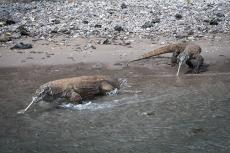Why are the Balinese waters so rich?
The source of the species richness in Balinese waters stems from Bali’s strategic position in the great systems of currents known as the Indonesian Throughflow.
It all starts east of the Philippines where the constant blowing of the tradewinds and the ocean currents forces huge masses of water up against the Philippines, where it is trapped and forced southwards.
Most of this current is directed by ocean bottom morphology to flow into the Sulawesi basin and down between Borneo and Sulawesi—the fat red arrow on the figure above. The only thing sitting in this giant current’s way is the lesser Sunda Islands, predominantly Bali, Lombok, Sumbawa, Flores and Timor—with Bali sitting right in the ideal position to benefit from this flow.
Approximately 25 percent of the total outflow into the Indian Ocean is passing through the 35km wide strait between Bali and Lombok, which is one of the main reasons why Bali is so immensely diverse. Every bit of fish life, plankton and eggs that get swept away pass through here.
But that is not all.
Bali, unlike most of the rest of Indonesia, also receives water from the Indian Ocean as well. While there is a net outflow from the Pacific into the Indian Ocean, there are periodic cycles that let in water from the Indian ocean and with it, its creatures, into Balinese waters.
The ocean south of Bali is the location for one of Indonesia's five major seasonal upwellings, the others being at West Sumatra, Makassar Strait, South Java and Banda Sea.
These upwellings bring cold but nutrient-rich waters up from the deep basins to the surface. In Bali’s case, this happens during the south-east monsoon, where the easterly winds generate a strong westward current along with Java, which in turn pulls water from the deep ocean basins south of Bali.

- Log in to post comments





















































